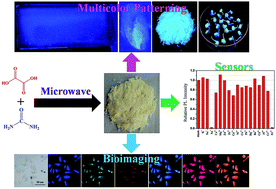High-quality water-soluble luminescent carbon dots for multicolor patterning, sensors, and bioimaging†
Abstract
An ingenious method for large-scale fabrication of water-soluble photoluminescent carbon dots (CDs) by a one-step microwave pyrolysis of oxalic acid (OA) and urea is developed. The structure and optical properties of the CDs are characterized by transmission electron microscopy, high-resolution transmission electron microscopy, X-ray diffraction patterns, elemental analysis, X-ray photoelectron spectroscopy, Fourier transform infrared spectroscopy, UV-vis absorption, and photoluminescence spectroscopy. The mechanism for the formation of the CDs is also discussed. In contrast to other CD-based nanomaterials, the as-prepared CDs exhibit high fluorescent quantum yield and excellent stability in both organic and inorganic phases. After simple post-treatment, the CDs are applied as fluorescent powder, showing their promising potential for further wide usage. In addition, the CDs can be utilized as a modification-free biosensor reagent capable of detecting Fe3+ and Ag+ in complex environments. The linear ranges for Fe3+ and Ag+ were 1.0–130 and 0.50–200 μM with the corresponding detection limits of 4.8 and 2.4 nM, respectively. More significantly, the CDs are superior fluorescent bioimaging agents in plants and cells based on their excellent water-solubility and ultra-low toxicity. Finally, the as-synthesized CDs are successfully applied for detecting Fe3+ and Ag+ in biosystems.


 Please wait while we load your content...
Please wait while we load your content...